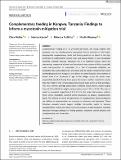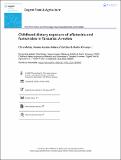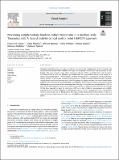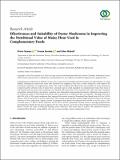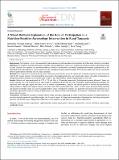Search
Now showing items 31-40 of 64
Complementary feeding in Kongwa, Tanzania: Findings to inform a mycotoxin mitigation trial.
(John Wiley & Sons Ltd., 2021-05-04)
Complementary feeding of 6- to 24-month-old infants and young children with adequate, safe and developmentally appropriate food is essential to child health. Inappropriate complementary foods and feeding practices are ...
Fluoride contamination of selected food crops, domestic water, and milk consumed by communities around mount Meru in Northern Tanzania.
(Taylor & Francis Online, 2021-01-24)
This study assessed fluoride levels in domestic water, commonly consumed food crops, cow's, and human milk. Samples of vegetables were collected from farmer's home gardens, green banana from local markets, maize flour, and ...
Childhood dietary exposure of aflatoxins and fumonisins in Tanzania: A review
(Taylor & Francis Online, 2020-12-24)
Aflatoxins (AFs) and Fumonisins (FBs) are common contaminants of maize, from secondary metabolites of fungi. Presence of AFs and FBs in maize-based complimentary food is evident in various studies conducted in Tanzania and ...
Variations in nutrient composition of oyster nuts (Telfairia pedata) across different agro-climatic conditions
(Taylor & Francis Online, 2021-04-27)
In sub-Saharan Africa, nutrient deficiency remains a challenge. The challenge is partly due to the underutilization of available local nutrient sources and failure to optimize nutrients based on agro-climatic conditions. ...
Risks of aflatoxin exposure among adolescents in boarding schools in Kilimanjaro region, Tanzania
(Wageningen Academic Publishers, 2021-04-12)
School feeding in low-income countries is dominated by cereals and legumes, which are susceptible to aflatoxin contamination but are usually not assessed for aflatoxins. A cross sectional study was conducted to assess ...
A Nutrition-Sensitive Agroecology Intervention in Rural Tanzania Increases Children's Dietary Diversity and Household Food Security But Does Not Change Child Anthropometry: Results from a Cluster-Randomized Trial.
(Oxford University Press, 2021-05-11)
Background
There are urgent calls for the transformation of agriculture and food systems to address human and planetary health issues. Nutrition-sensitive agriculture and agroecology promise interconnected solutions to ...
Processing complementary foods to reduce mycotoxins in a medium scale Tanzanian mill: A hazard analysis critical control point (HACCP) approach
(Elsevier, 2024-03-22)
Designing and implementing processing procedures for producing safe complementary foods in dynamic and
unregulated food systems where common food staples are frequently contaminated with mycotoxins is chal-
lenging. This ...
Effectiveness and Suitability of Oyster Mushroom in Improving the Nutritional Value of Maize Flour Used in Complementary Foods
(Hindawi, 2021-03-16)
Complementary foods based on habitual cereals such as maize have been linked with the promotion of undernutrition in young children. Blending the starchy-rich maize with nutritious-rich indigenous food such as oyster ...
Food security mediates the decrease in women's depressive symptoms in a participatory nutrition-sensitive agroecology intervention in rural Tanzania.
(Cambridge University Press 2021, 2021-03-12)
Objective:
To investigate if food security mediated the impact of a nutrition-sensitive agroecology intervention on women’s depressive symptoms.
Design:
We used annual longitudinal data (4 time points) from a ...
A Mixed Methods Exploration of the Role of Participation in a Nutrition-Sensitive Agroecology Intervention in Rural Tanzania
(Elsevier, 2023-06)
Background: Participation is key to the successful implementation of nutrition-related interventions, but it has been relatively overlooked.
Objective: We sought to describe participation intensity among smallholder farmers ...

